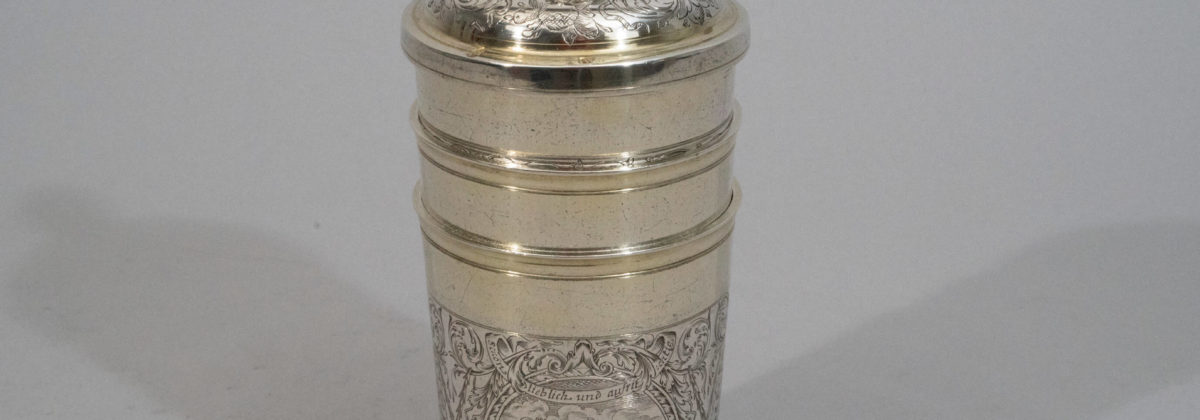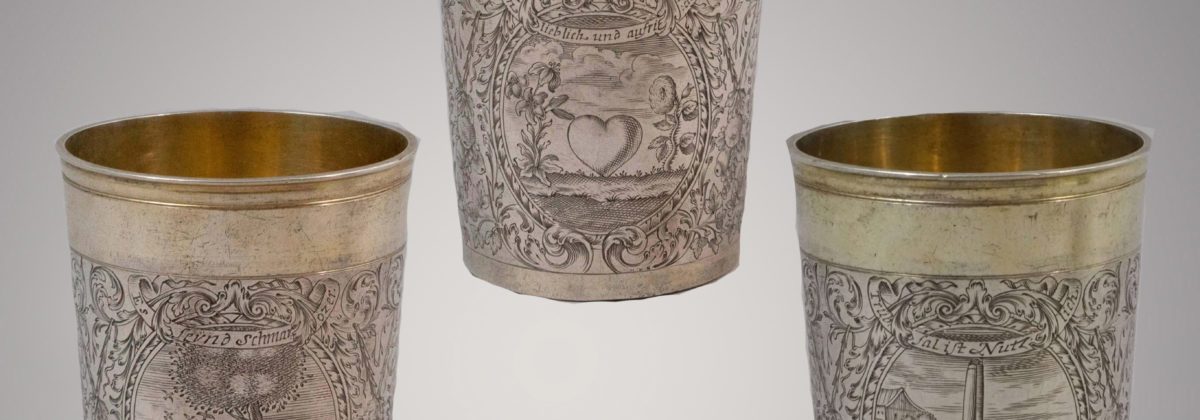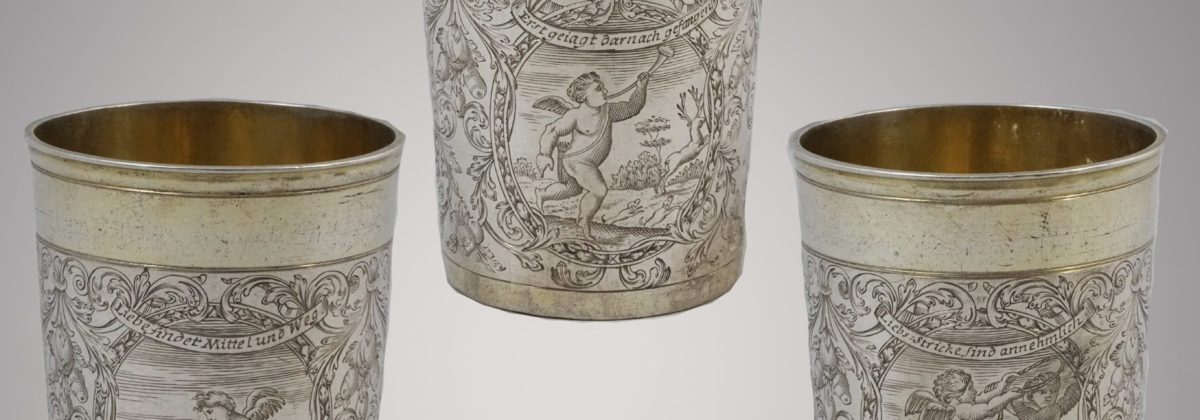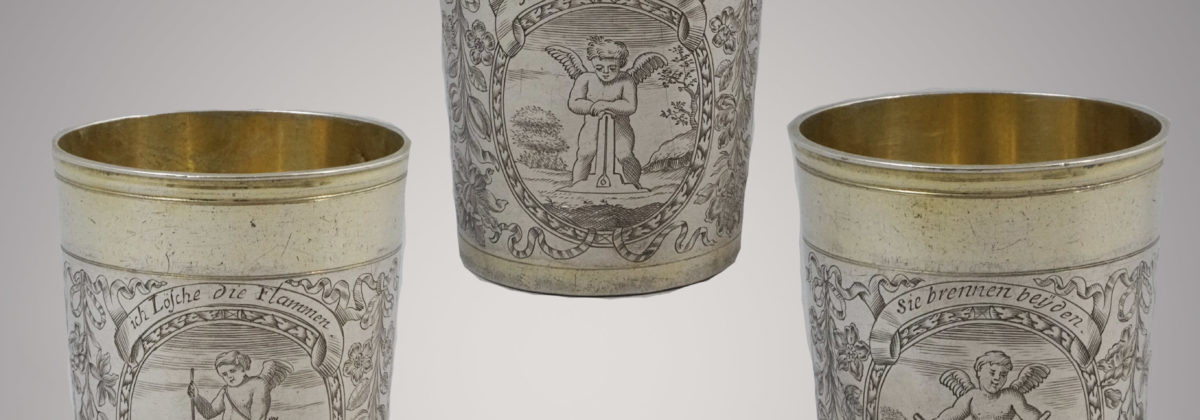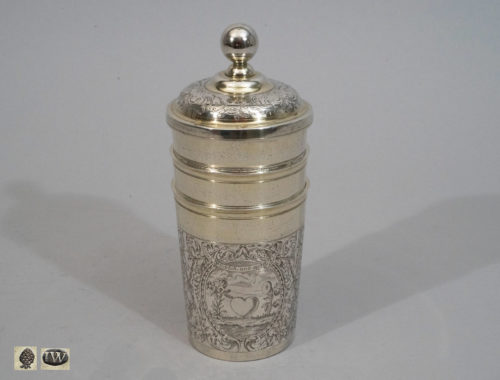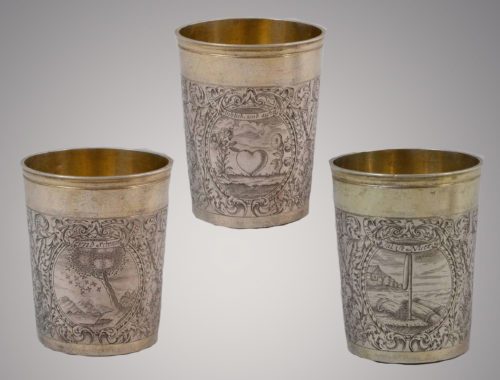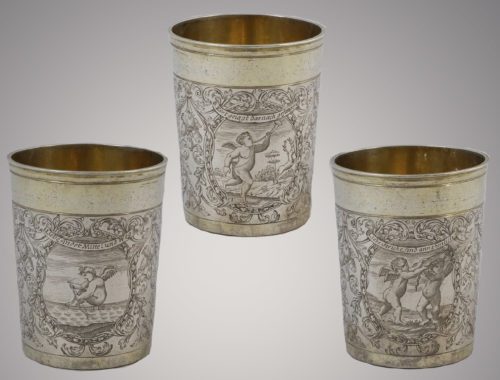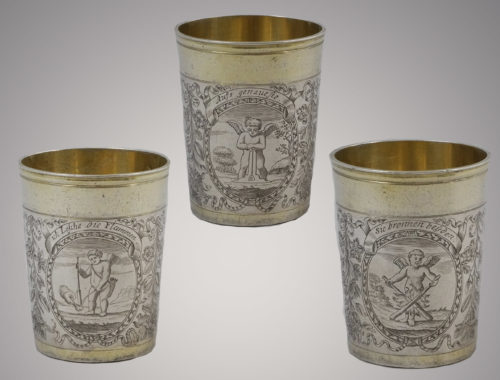Detailed Description
“Omnia vincit amor” (Cupid conquers everything) is the theme of the three richly engraved stacking beaker with a lid. You can’t resist the charm of Cupid. Its history goes back to Greek and Roman antiquity. Because he was able to move outside of social constraints and regulations, he enjoyed great popularity in both the Renaissance and the Baroque periods.
![]() Cupid is often depicted in 17th century emblem collections, for example in Otto van Veen’s Amorum emblemata, figuris aeneis incisa, printed in Antwerp in 1608, who may have been the inventor of some of the scenes used here. The emblem collection by Heinrich Oeffelen, printed in Augsburg in 1693, served as a direct model for the nine scenes depicted: “Emblematic mind-pleasure when contemplating the most curious and delightful symbol(s)…” with multilingual captions. Not only the iconography was taken from this collection, but also the associated sayings, which are important for further explanation for the viewer.
Cupid is often depicted in 17th century emblem collections, for example in Otto van Veen’s Amorum emblemata, figuris aeneis incisa, printed in Antwerp in 1608, who may have been the inventor of some of the scenes used here. The emblem collection by Heinrich Oeffelen, printed in Augsburg in 1693, served as a direct model for the nine scenes depicted: “Emblematic mind-pleasure when contemplating the most curious and delightful symbol(s)…” with multilingual captions. Not only the iconography was taken from this collection, but also the associated sayings, which are important for further explanation for the viewer.
The three cups each show three cartouches with banners arranged in a high oval. They are surrounded by elaborately engraved tendrils and framed by fruits, flowers and tailwork, which the engraver mastered with outstanding ease.
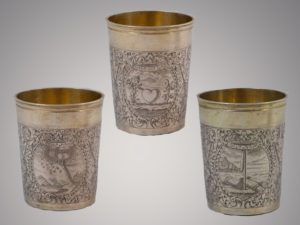
THE FIRST CUP
The first beaker gives a clear indication of the series’ motto – love. A heart is depicted surrounded by a lily and a rose under the caption: “Beautifully lovely and sincere” (Oeffelen, plate 24, no. 10): This is how love should be.
Another cartouche shows a cherry tree with a flock of birds flying towards it. A scene that the goldsmith Johann Wagner used at least one more time. The motto above is: “They are parasites”. In Oeffelen, Plate 3, No. 15, the same saying describes various birds flying to a cherry tree full of fruit in order to plunder it. The birds love the irresistible fruits so much that they attack them passionately.
The last cartouche shows bundled sheaves of grain and an upright flail in front of a courtyard with the motto: “Tribulation is useful”. In Oeffelen Plate 7, No. 13 there are also birds depicted in the sky that are interested in the grain, while the farm is missing. The reference to sheaves of grain that are just about to be threshed makes it clear that love not only requires a lot of work, but is also exposed to insidious attacks from outside.
The other two cups each show three scenes depicting Cupid / Cupid doing different activities:
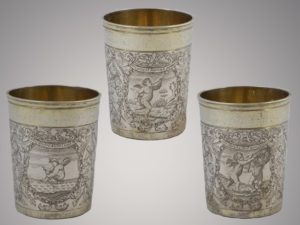
THE SECOND CUP
Cup two shows a winged putto holding his bow in his hand and riding over the water while sitting on his quiver. Above it is the amusing saying: “Love finds a way and a way.”, Oeffelen, plate 19, no. 15: Even the seemingly impossible can work in love.
Another cartouche shows a striding Cupid with a quiver hanging around his neck, blowing the hunt with his horn raised and pursuing a deer with the help of three dogs. Above it is the saying: “First get caught afterward.” In his excitement, Cupid has forgotten his bow… it is already missing in Oeffelen, plate 25, no. 15, but is in Otto van Veen, the inventor of the depiction on p. 131 Still to be seen: However, it is generally known that distraction is possible in love and that outside help can be necessary.
The third cartouche shows a Cupid catching another with a rope, above which is the motto: “Love’s ropes are acceptable”. Just as in Oeffelen, plate 49, no. 15, two cupids are shown playfully wrestling: the one on the left smiles mischievously and confidently of victory, while he tries to catch the one on the right with a rope. The man on the right raises his hands defensively and turns his head to the side, but squints smugly at his opponent: the two are obviously in the process of getting together – blades of grass are sprouting at their feet.
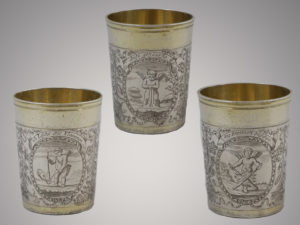
THE THIRD CUP
The third cup also shows cartouches with cupids. A Cupid with outstretched wings leans thoughtfully on a ruler – a testing or measuring instrument used in construction. Above this is the motto: “To the greatest detail” as is also the case in Oeffelen, plate 46, no. 10, which reminds us to be careful when choosing a partner and which Friedrich Schiller later sums up in “Then check who commits himself forever”.
In the next depiction, the winged Cupid pees on his torch with the slogan “I put out the flames”. As with the Brussels landmark, the so-called “Männeken Piss”, which was designed by Jérôme Duquesnoy and has stood on a Brussels fountain since 1619, Armor stands in a casual pose and does his business. He is described in more detail in Oeffelen, plate 35, no. 8: Here Cupid extinguishes his love and passion himself.
In complete contrast, the third Cupid, smiling mischievously, holds two burning, crossed torches downwards. These were traditionally seen as a symbol of a good marital life. The words “They burn both” were engraved above it, which can also be found in Oeffelens, on plate 46, no. 3.
The ensemble of three setting cups with a lid with tendrils and a spherical knob is dedicated to the many different facets of love – which are usually represented by cupids and illustrated by sayings. It may have been given as a precious gift to a newlywed couple.
THE GOLDSMITH
Numerous goldsmith works are known from the goldsmith Johann Wagner, born in 1646, who worked between 1677 and 1724. He preferred to create fish skin cups, lidded cups on ball feet and partially gilded cups, often decorated with engraved foliage, tendrils and fruit bundles, but also made a porridge bowl. Many of his works are in international museums such as the Kremlin and the Historical Museum in Moscow, the Augsburg Municipal Art Collections as well as in the National Museum Budapest and in the Zornsamlingarna, Mora/Sweden.
LITERATURE
Hernmarck, Carl: The art of European gold and silversmiths from 1450 to 1830, Munich 1978, pp. 76-85
Seling, Helmut: The Augsburg gold and silversmiths 1529-1868, Vol. I-III, Munich: Beck Verlag, 1980-2007, especially Seling 1980, Vol. 1, Fig. 363, Mz. No. 1750
ONLINE LINKS
Offelen, Heinrich: Emblematic emotional pleasure when contemplating the most curious and delightful symbols with their relevant German-Latin-French languages. and Italian descriptions, Augsburg 1693, plates 3, 7, 19, 24, 25, 35, 46, 49
https://embleme.digitale-sammlungen.de/loadframe.html?toc_name=gemue_augsbu.html&img_id=img_gemue_augsbu00001
Veen (Vaenius), Otto van: Amorum emblemata, figuris aeneis incisa, Antwerp 1608, pp. 77, 89, 93, 131, 134
https://archive.org/details/amorumemblemataf00veen/page/n11/mode/2up


